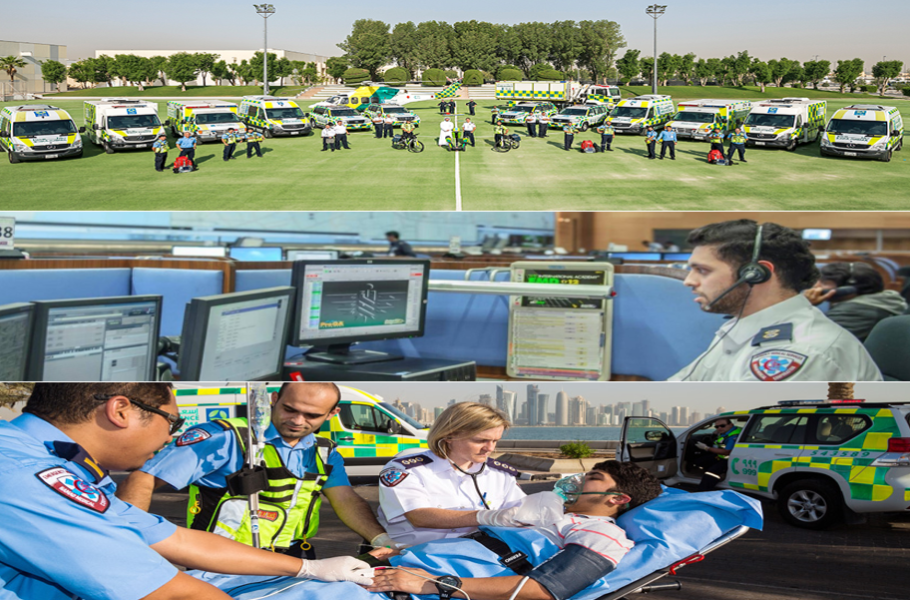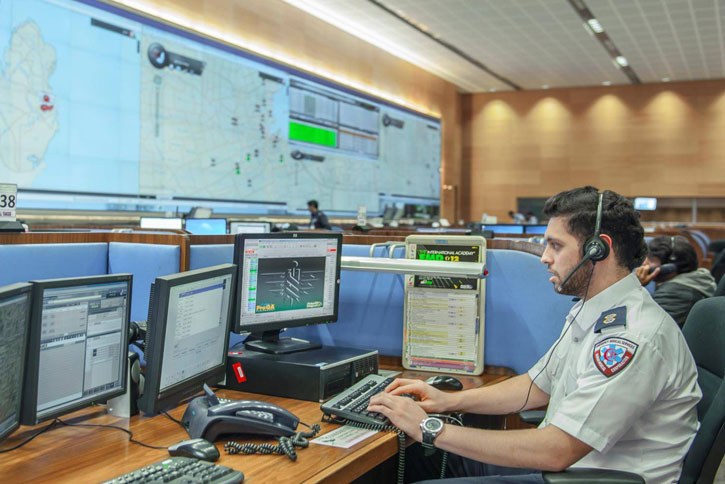
If you’re faced with a life-threatening situation or a medical emergency and feel that driving to the hospital may take too much time or you or someone has an injury that may get worse if you try to get them into a car, do not hesitate even for a second. Call 999 and request for an ambulance from Hamad Medical Corporation's (HMC) Ambulance Service.
The HMC Ambulance Service plays a vital role for the people who live in Qatar - one that saves lives. It transports and treats casualties, injured and sick patients all over the country, and it's all FREE OF CHARGE!

HMC’s ambulance service is committed to providing the foundations for exemplary treatment that conform to international standards and delivering the best medical treatment to accident casualties and those caught up in other serious, potentially life-threatening medical emergencies.
Every emergency that the Ambulance Service is called out to offers different challenges in terms of the type of injuries, the number of people affected by the emergency incident, the location of the incident and the kind of support that’s required. On an average, HMC’s Ambulance Service receives 200,000+ calls every year, to which 1,454 staff, 167 ambulances, 20 rapid response vehicles and HMC’s fleet of helicopters respond to as fast as possible.

The average time HMC's ambulance service takes to respond to emergency calls in Qatar is faster than the target set by Qatar's first National Health Strategy in 2011. In 2018, the ambulance service responded to approximately 115,000 priority one calls - the most urgent category of calls - in an average time of approximately seven minutes within Doha and 8.2 minutes in the rural areas of Qatar. These impressive response times have been achieved despite an increase in the number of calls received by 999 every year.

In case of a potentially life-threatening casualty or medical emergency, the first thing to do is call 999. Time is critical at this point, and it should not be wasted. As soon as the call to 999 is answered, the rescue operation process is triggered.
The steps taken by the HMC Ambulance Service in the operation process is described below:
The call to 999 will be answered by the National Command Centre, operated by the Ministry of Interior. In case of an accident, the call is passed on to an experienced dispatcher, who is responsible for organising which ambulance service vehicle is required and what kind of primary care is required depending on the emergency situation, location, type and severity of the accident or emergency.
When the call to 999, is directed to the dispatcher, it's important that the caller :

Based on the information given during the emergency call, the dispatcher at the emergency control centre determines which ambulance to send to the location of the incident. If necessary, he/she will consult with a team of experts to ensure flawless operations and swift medical help is provided and the correct ambulance vehicle is dispatched.
The emergency vehicle nearest to the emergency location is alerted and if the emergency is life-threatening, a helicopter is alerted because it can get back to the emergency department faster.
If the emergency is life-threatening, the relevant emergency care department is informed so that as soon as the ambulance has delivered the patient to the emergency department, they are already aware of the patient's condition and can commence the appropriate treatment immediately.
As the appropriate ambulance speeds to the location of the emergency, the dispatcher stays on the line with the caller to keep him/her updated about the rescue process and to stay informed about the condition of the injured or those that need medical assistance.

As soon as the ambulance has reached the emergency scene, the paramedics inform the dispatcher and then begin evaluation of the situation and the person/people who require medical assistance.
The paramedics are trained to assess the scene and make a clinical decision as to whether the patient needs to be immediately loaded and transported to the hospital or if stabilisation and medical treatment at the scene are the only requirement.
The rescue time can vary from just a few minutes to several hours, depending on the patient’s condition. No matter how long it takes, the paramedics and the emergency service control centre communicate with each other to ensure that the patient is provided with the best care possible.

While en route, paramedics monitor the patient’s vital signs and take further actions if required. The control center will also give the hospital a brief verbal report of the situation during the journey to the emergency department. This provides the hospital staff enough time to prepare everything they need for further treatment.
On arriving at the hospital, paramedics accompany the patient inside and give a more detailed report to the emergency department nurses or to the emergency department doctor as the case may require.

HMC’s Ambulance Service's ‘know the 5 to save a life’ national awareness campaign is targeted towards educating the public in Qatar about the five different actions that need to be taken when dialling for an ambulance in case of an emergency situation. The campaign first ran in 2013 and was relaunched in 2019 as a reminder to people so that ambulances can provide the best support possible as fast as possible and more lives can be saved by doing the five actions, you can find in the following link: https://www.iloveqatar.net/news/healthWellness/know-the-5-to-save-a-life-when-dialling-for-an-ambulance

HMC has a fleet of state-of-the-art ambulances and helicopters, operating from its central headquarters in Doha along with a team of experienced paramedics and emergency care doctors who administer first aid to accident casualties or those caught in other medical emergency situations before transporting them to the appropriate emergency department.
These ambulances have been designed for easy navigation through traffic, for quicker access to emergency cases and are environment-friendly. This helps optimise the emergency response time. The interiors are fitted with new technologies, adequate lightening, smart air-conditioning that can help infection control and other effective materials.
In recent years the HMC Ambulance Service has introduced a new state-of-the-art ambulance fleet, expanded the LifeFlight Service, and built dispatch points around the country. These steps have enabled the service to reach patients quickly, regardless of their location.
Many a times, you must have seen the following ambulance units driving on the roads of Qatar rushing to an emergency or back to the hospital to save a life. Find out more about the different units and what they are responsible for.

Vehicle: Ambulance
Vehicle staff: Two ambulance paramedics
Type: Emergency transport

Vehicle: 4X4 response vehicle
Staff: One Critical Care Paramedic (CCP) and one ambulance paramedic
Type: Emergency response to calls which require advanced medical interventions (clinical supervisory duties)

Vehicle: 4X4 response vehicle
Staff: One distribution supervisor
Type: Emergency response (scene management and operations supervisory duties at the scene of an emergency)

The HMC LifeFlight is used for fast transit from emergency scenes to HMC hospitals. All of the helicopters are equipped with the latest advanced life support medical equipment and carry two medical crew and two pilots. The efficiency of the Ambulance Service is an important element in providing critical care to patients, especially those who are not in the close vicinity of the city.

Making use of specially designed rapidly deployable containers, these vehicles are equipped with all the necessary requirements to deal with a major incident in their three type configurations, namely: medical, decontamination and logistics. In the event of a major incident, these units can be deployed by the Specialised Emergency Management team within the HMC Ambulance Service to provide emergency medical support.
Medical Vehicle
The medical vehicle contains all the resources required to create a temporary field treatment area with a variety of air conditioned tents in which patients can be treated according to their clinical acuity. The units are staffed by specially trained crews who will rapidly deploy all the necessary shelters and equipment in preparation for the treatment and stabilisation of patients by Ambulance Paramedics and Critical Care Paramedics prior to transferring them to one of HMC's Emergency Departments.
Decontamination Vehicle
The medical decontamination unit enables clinical teams to support other emergency response agencies in the event of a major incident involving a hazardous material. The aim is to deploy these vehicles to major incidents involving multiple casualties to assist Emergency Departments with surge capacity and decontamination, as well as to any large scale event where there are more than 25,000 people, to ensure that they are on hand should there be any adverse event.
Logistics Vehicle
In addition, a set of trucks are stationed at Hamad International Airport in preparedness for any major aircraft or ground emergency at the airport or offsite. The other units are stationed around the country, so they are available when required.

HMC ambulance teams continue to perform their usual role in responding to all reports and emergency situations in the Sealine area 24/7. The number of ambulances increases during the weekends at Sealine. There are the standard response ambulances and 4x4 vehicles which are used to transport patients from the sand dune areas to either the clinic, a standard ambulance vehicle, or to the helipad, along with the presence of two helicopters that also respond to cases that are difficult to reach with ambulances, especially those that involve serious injuries and critical situations.

The Sealine 4x4 ambulance fleet units can respond to emergencies throughout the sand dunes without any obstacles and in record time because the technical specifications of these all-wheel drive ambulances have been designed and modified with the latest safety equipment and supplies to suit the geographical nature and special terrain of the Sealine and its surrounding areas, so they can reach patients safely and with great flexibility and ease.

It’s true that the Ambulance Service’s emergency response is the feature of this HMC service which most people living in Qatar are most familiar with, but there is more to the HMC Ambulance Service than being there when you need it the most!
In addition to responding to more than 200,000 emergency calls each year, HMC’s Ambulance Service also carries out over 50,000 non-emergency transfers of patients. These non-emergency transfers include moving patients from one HMC hospital to another, as well as transporting patients with mobility problems from their home to a hospital for their appointment.
The Ambulance Service provides the people in Qatar with a number of services which include:
Cover image credit: Hamad Medical Corporation
How informative has this guide been for you? Have you ever had to call an ambulance here in Qatar? If yes, how was your experience? Do let us know your thoughts in our Comments section. Like and share the article - it keeps us going!
Follow us on our social media channels:
![]() @ILQlive
@ILQlive
![]() @ILQlive
@ILQlive
![]() @ILoveQtr
@ILoveQtr
![]() ILoveQatar
ILoveQatar

You have successfully registered your account!
Please confirm your e-mail address by clicking on the URL sent to you.The e-mail usually arrives in 5-10 minutes.
How ajeeb was that!? Thanks for contributing to our community! Your post will appear after we take a quick look!